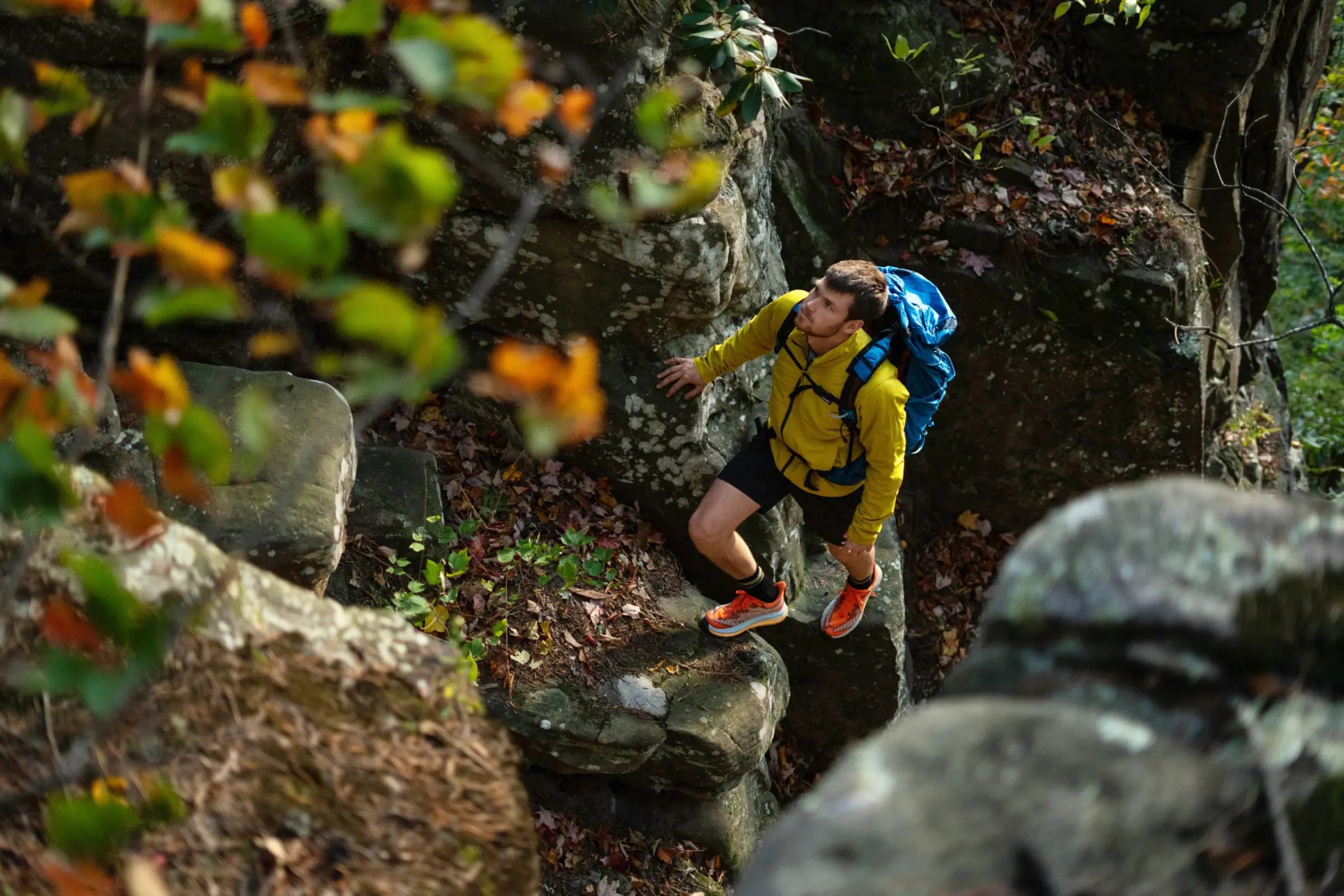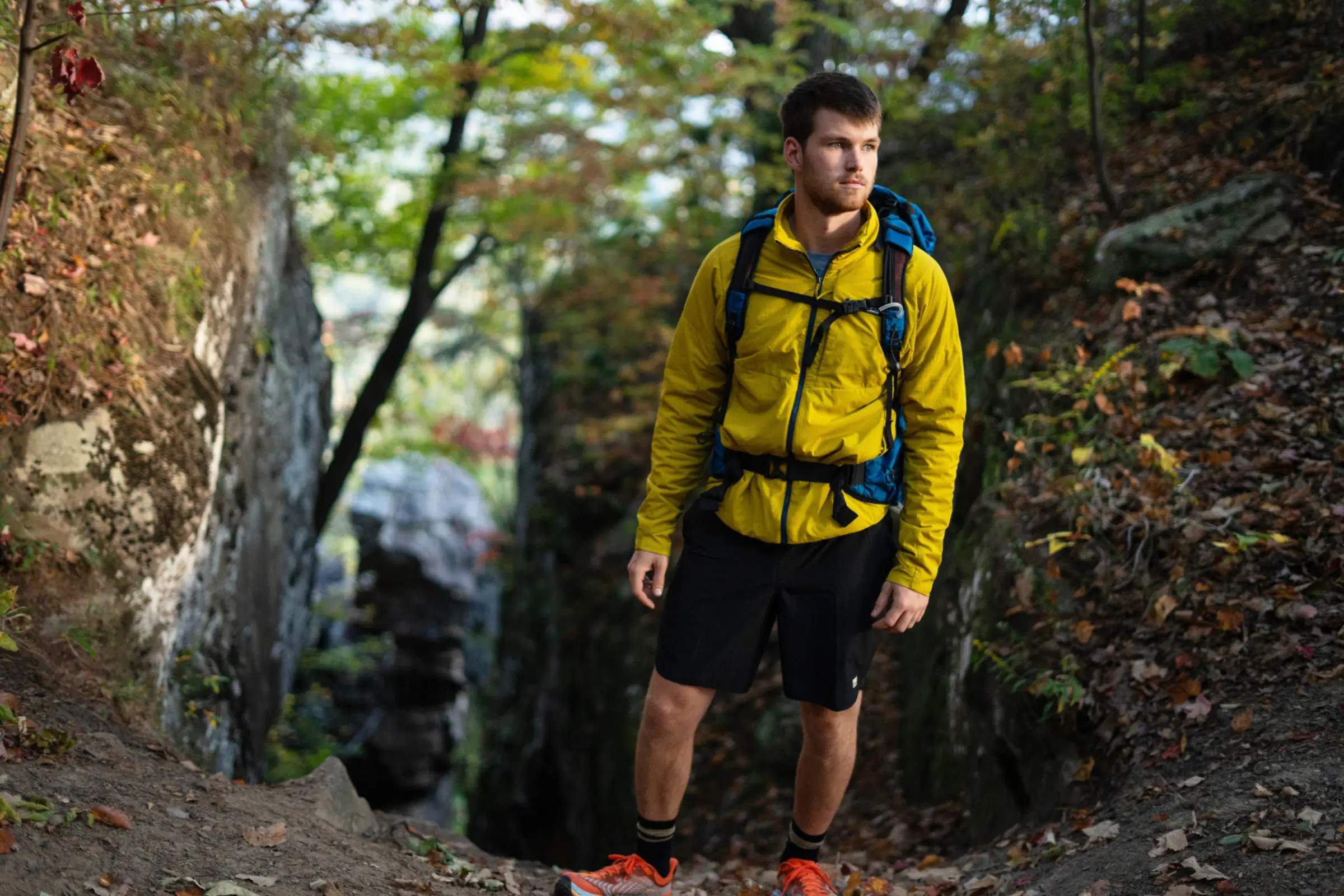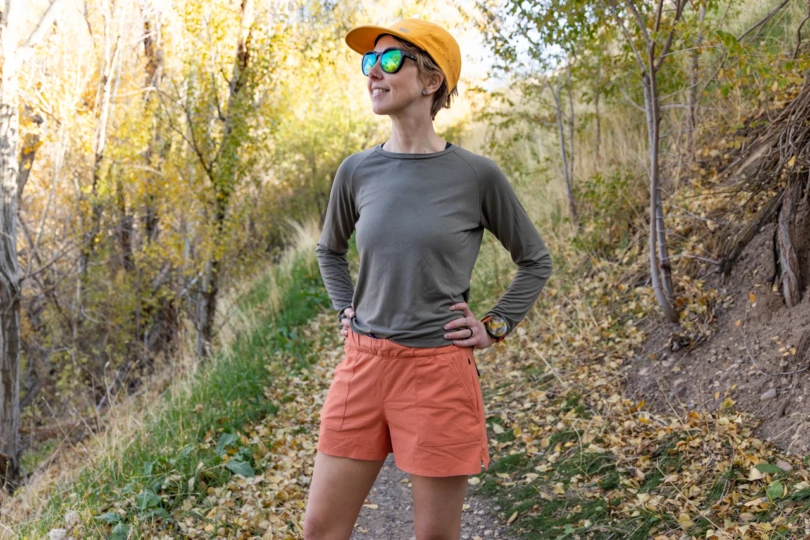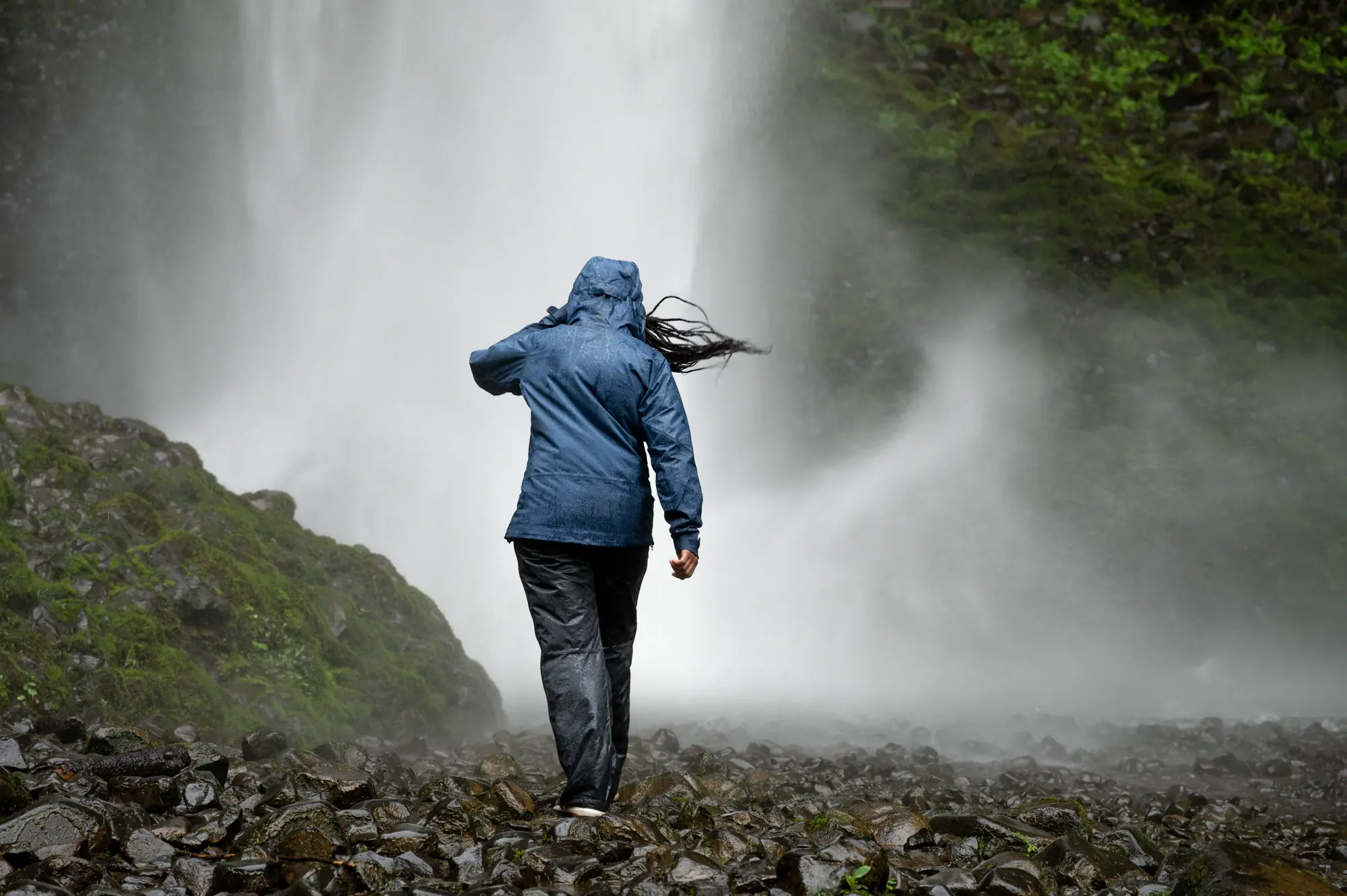We all know the shoulder seasons are where it’s at. Perfect climbing temps, stellar trail-running weather, and phenomenal backpacking conditions combine to keep outdoor athletes perpetually active. However, finding the right layers for these idyllic months can present some difficulty. High-intensity activities often become a juggling game of base layers, midlayers, and puffies in an ongoing battle with temperature and moisture buildup.
You’re cold while standing around, and you heat up fast when cranking again. It’s rare to find a jacket you barely ever take off over the duration of an adventure, but the revolutionary Nano-Air seeks to ease this dilemma.
Patagonia filled this layer with the unique FullRange insulation, a 60g polyester material that delivers solid warmth and unprecedented air permeability, dumping excess heat during activity.
This insulation, combined with an exceptionally breathable polyester plain-weave shell fabric, makes for a super-ventilated combo that allows you to wear the Nano-Air for the duration of your adventure.
In short: While the Nano-Air ($249), available in men’s and women’s options, isn’t the warmest layer you can find, it’s noticeably more breathable than most of its competition. This makes it one of the more popular active midlayers you can buy. If you are looking for a versatile, extremely breathable jacket for a multitude of high-output activities, it’s hard to find a better option out there.
To see how the Nano Air compares to other top-tier midlayers on the market, check out GearJunkie’s Best Midlayers Buyer’s Guide.
- Insulation: 60g FullRange, 100% polyester (40% recycled)
- Weight: 11.2 oz. (men's medium)
- Key features: Stuffs into its own chest pocket, unique breathable insulation, stretch fabric and insulation designed for maximum movement
- Pockets: Two zippered hand-warmer pockets and one chest pocket that doubles as a stuffsack
- Shell fabric: 100% polyester plain-weave with a PFC-free DWR finish
Pros
- Stellar breathability
- Super comfortable fabric
- Lightweight
- Quite durable compared to previous models
Cons
- Not as weather-resistant as other jackets
- Not as warm as other models
- Slim fit makes it hard to roll up sleeves or add layers underneath
Patagonia Nano-Air Jacket Review

Testing the Nano-Air
Since breathability is one of its primary selling points, I tested the Nano-Air with this at the forefront. In addition to how well it regulates temperature and moisture buildup, I tested the Nano-Air for its resistance to wind and light precipitation, packability, and overall durability.
After taking it on several tasking trips, including weekend pushes on the Appalachian Trail and long multipitch climbs, I can say with a certain degree of confidence that this promises to be one of the most comfy and reliable active insulation jackets on the market.
Breathability

The secret to the Nano-Air’s stellar ventilation lies in the stretchy, warm, breathable FullRange synthetic insulation Patagonia used.
Designed by Toray Mills in Japan, FullRange is a multi-denier synthetic insulation made from several different types of polyester fibers. This isn’t the warmest shell — and is quite thin — but it works wonders during high-intensity activity on cold missions.
As a standalone outer layer for slow or static adventures, it would be best to look for something warmer, as the Nano-Air is designed to be used while generating a lot of body heat during activity. But as a versatile jacket that you don’t have to shed when you really start moving, it makes a great choice.
I found it to be one of the more comfortable active layers I’ve tried. It also became one of my favorite shells to wear on long multi-pitch climbs in shoulder season temps. I hate having to constantly pull jackets on and off while managing ropes and gear hundreds of feet in the air. So something I can keep on while both climbing hard and belaying is good by me.
For climbing, hiking, and even light trail running in cold conditions, the Nano-Air delivered an appropriate amount of warmth when I needed it, and dumped excess heat while pushing hard. If I stopped for too long, or wore it as my only insulating shell while setting up camp or sitting around the fire, I often found myself adding another layer.
The downside of most breathable jackets is wind can easily cut through the fabric and insulation. In stormy conditions or on windy ridge walks, pairing the Nano-Air with a windbreaker or rain shell helps with that issue.




Out of all the insulating jackets I’ve tried, the Nano-Air’s lining probably has the best next-to-skin comfort, which makes it feel more like a fleece midlayer than a synthetic puffy. I consequently wore it more with just a T-shirt underneath than I usually do with an insulating layer, which further increased airflow and helped reduce moisture buildup.
One negative I noticed, however, was that the cuffs of the sleeves fit quite tight on my wrists. This made it difficult to roll the sleeves up my arm, which is super helpful when you want to dump heat fast.
Water Resistance
As is expected with synthetic insulation, the Patagonia Nano-Air Jacket did a good job of retaining its loft and warmth when wet. The DWR finish on the outer fabric somewhat repelled light precipitation, but I felt like water absorbed faster into this jacket than some other fabrics. Maybe it’s because of how soft it is.
If bad weather is in the forecast, I would definitely recommend bringing along a dedicated rain shell, as the air-permeable fabric and insulation allows wind to move right through the jacket.
With that said, the Nano-Air does dry out fast, so when I did find myself in sustained drizzles it wasn’t too much of a problem.
Warmth


While moving fast on climbs, hikes, and runs, I stayed super warm in this jacket but didn’t overheat like I might have in less breathable shells.
As stated earlier, if you are looking for maximum warmth in a jacket, the Nano-Air isn’t for you. It will keep you toasty as you generate heat while active, but if you’re going to be standing still in super cold temps or hiking through hard wind, you’re going to want to at least pair it with something else.
I found this to be an almost perfect midlayer for backpacking and climbing excursions during the shoulder seasons, or as a standalone puffy for warmer summer trips. I loved wearing it when I knew I was going to be exerting a lot of energy.
Durability
There have been reports of past Nano-Air models wearing down faster than usual due to its incredibly soft fabric, but I really didn’t find that to be an issue with the newer update. The fabric is not rip-stop, but I have yet to put any holes or tears in it to see if that will be a big issue.
After some pretty heavy use, it still looks as good as new. I also didn’t feel like it was too fragile to do some off-trail bushwhacking while scoping out new climbing areas.
Aside from some small picks and stains, it has held up quite well over months of use and has shown no signs of premature pilling in high-wear areas.
Weight and Packed Size


At 11.2 ounces for a men’s medium, the Nano-Air is on the lighter end of the spectrum for synthetic jackets. For me, given how comfortable and soft the fabric is, this seems pretty great.
The jacket stuffs into its chest pocket, and has an integrated carabiner loop for attaching it to your harness while climbing. This was an appropriate weight and size for throwing into my pack on almost every high-activity trip I went on, and it didn’t feel unwieldy while dangling from my harness.
I probably wouldn’t bring it as a standalone insulating layer for longer backpacking journeys like a thru-hike where you may be trekking through multiple seasons and climates, but for summer and shorter trips on the trail, this found its way into my pack.
Given how soft and breathable it is, I’d say Patagonia did a good job of keeping it competitively lightweight.
Key Features




The Nano-Air is quite minimalistic but still has a functional design. Stretch fabric and insulation combines with strategically placed, low-profile quilting that offers an adequate range of motion.
However, I did feel a little constrained while reaching at my limit on climbs or trying to grab something from my backpack behind me.
It is a “slim-fitting” jacket, which makes it difficult to add additional layers underneath, and it does feel somewhat tight and constricted. That gripe aside, I personally like a more athletic fit, and it didn’t hold me back too much during most activities.
Patagonia Nano-Air Jacket: Conclusion
For start-stop aerobic mountain pursuits, the Patagonia Nano-Air Jacket won’t slow you down by having to constantly adjust your layers. While not the warmest jacket on the market, if you are looking for a versatile shell with top-of-the-line breathability for sustained activity, this is a solid option.








